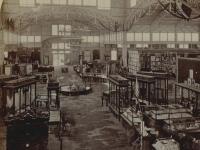On May 10, 1876, amidst the high-flying American flags and the grandeur of the ornate buildings before them, 100,000 people gathered to hear President Ulysses S. Grant open the Centennial Exhibition of 1876. After a bloody Civil War, and a failed Reconstruction, Americans wanted to prove their greatness once again. The International Exhibition of Arts, Manufactures, and Products of the Soil and Mine, or the Centennial Exhibition, showcased this rapidly growing nation, in addition to the work of 37 other nations. Philadelphia’s Fairmount Park was lined with pavilions, hosting exhibits that demonstrated the new industrial and technological advancements of the age. Bringing in over nine million visitors, the Centennial Exhibition celebrated America’s birthday by introducing the country as a world power. William Dean Howells observed, "no one can see the fair without a thrill of patriotic pride."
Although world’s fairs encouraged patriotism, technological innovation, entertainment, and exchanging of ideas, the fairs reflected profound concerns about the future and deflected criticism of the established political and social orders. Philadelphia’s Centennial Exhibition was developed as an organized response to class conflict in the aftermath of the Civil War, Reconstruction, and industrial depressions that occurred in the 1860s and 1870s. The Centennial Exhibition offered an escape from these gloomy vistas, and served as a calculated response to these conditions. As an attempt to restore vitality in the United States, the Centennial Exhibition operated as a “school for the nation,” a place where Americans and their international guests could learn the national narrative, technological power, and unify as a nation once again. The Centennial Exhibition offered organized curated experiences, meant to look to the glorious past, serving as a blueprint for the future.
Although seemingly beneficial for American morale, the entire nation did not fully support it nor were they included in the planning. When the federal government did not and could not provide money for the exhibition, as the Panic of 1873 made it difficult to appropriate funds, elite Philadelphians raised money to hold the exhibition. Since this group funded and planned the event, it showcased other elite Americans, excluding lower and working-classes from attending or exhibiting. This lesson will allow students to engage with primary sources, in order to interpret the Centennial Exhibition from the point of view of its guests, and the view of those excluded from the fair. Using newspapers and images, the students will be able to understand the Exhibition’s guests and what they experienced at the fair, as well as understanding the relationship of the fair with working and lower class Americans. Why weren’t all people equally represented at the Centennial Exhibition?



